The number of games that Erwin van de Looi has left of his tenure as the Netherlands U21s boss will be determined by how far the country go in the upcoming U21s European Championships.
This is the final opportunity for Van de Looi to showcase his work over the past five years, ever since initially taking the reins in 2018. It’s like having one final exhibit for a retiring artist.
Van de Looi has coached some unbelievably gifted players over the past half a decade, from the likes of Sven Botman to Jeremie Frimpong to Ryan Gravenberch to Brian Brobbey. The future of the Oranje is in very good hands.
The last time the Netherlands were in this competition, they reached the semi-finals and eventually finished third overall, with Germany winning the tournament outright. It was a respectable finish for Van de Looi’s younglings but one that the manager will be hoping to better this time around.
There are a lot of players in this squad with a history of international glory. Four years ago, the U17s beat Italy in the final of EURO U17 in Ireland. A number of those very same players will be featuring for the European giants this summer, including Ian Maatsen, Dirk Proper, and Anass Salah-Eddine.
The Dutch squad is stacked with quality and possesses players from some of the finest youth academies in football. However, the style of play is what stands out the most when watching the team, as well as the players’ ability to adhere to the tactical principles set out by the manager.
With that in mind, this tactical analysis piece will be a scout report looking at the tactics that we can expect from Van de Looi this summer. Within this analysis, we will break down each department too, picking out the key players for the Jong Oranje this summer while also attempting to predict their starting XI.
Predicted Starting XI
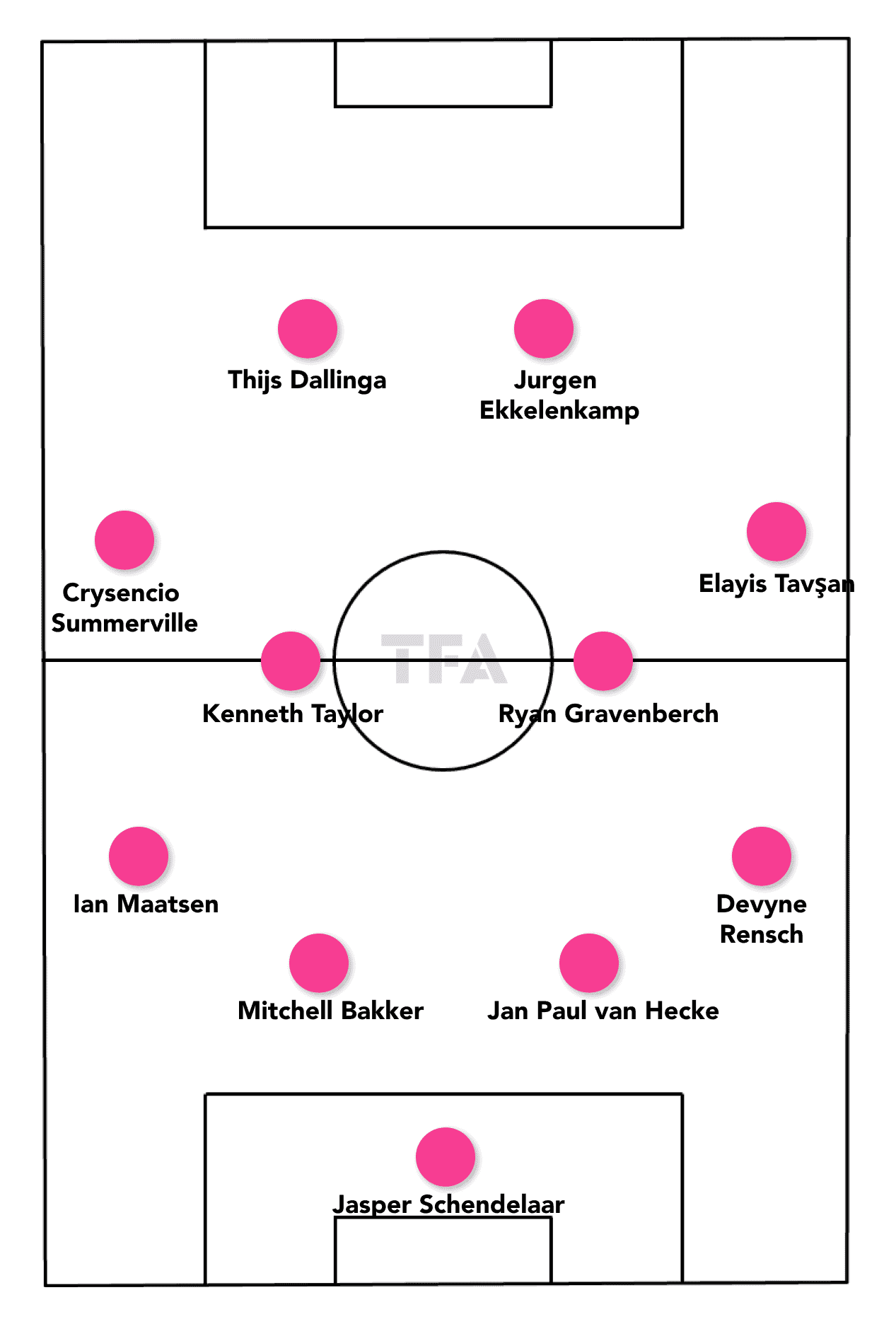
The predicted XI and squad for this team scout report was based on both the provisional squad which was released mid-May as well as the squad that was called up for the recent international friendlies against the Czech Republic and Norway back in March. The squads may not be entirely accurate compared to the final list but we’ve tried to get it as close as possible.
Under Van de Looi, the Netherlands have mainly set up in a 4-4-2 formation and so this will likely be the team’s choice of structure in the upcoming tournament.
In the two friendlies, Van de Looi switched between Jay Gorter and Jasper Schendelaar in net but Schendelaar is potentially the stronger of the two right now, although there is a high chance that Kjell Scherpen could get the nod too — all 6’9” of him.
This will likely be the backline given the way that Van de Looi likes to play. Each fullback has to be comfortable in the central areas and both Devyne Rensch and Ian Maatsen certainly are while the centre-backs must be able to play through the lines. Given the way Jan Paul van Hecke and Mitchel Bakker play for both Brighton and Bayer Leverkusen, respectively, it makes sense to start with this duo in the heart of the defence.
The double-pivot could be comprised of the incredibly talented duo of Kenneth Taylor and Ryan Gravenberch, former teammates at Ajax, although Wouter Burger and Dirk Proper were the manager’s preferred duo during the recent international break.
On the flanks, we predict that Leeds United’s highly-rated winger Crysencio Summerville and Elayis Tavşan will be the main men chosen together this summer. Van de Looi used this combo against Norway in a friendly a few months back and they shone like bright lights, particularly the former who could be a real threat for the Netherlands in this competition.
Finally, there were a lot of options up top but we went with the duo that impressed us the most and that is Toulouse’s Thijs Dallinga and Jurgen Ekkelenkamp who work really well together. Dallinga plays as the proper number ‘9’ while Ekkelenkamp drops deep and picks up the ball in pockets of space which we will analyse in further detail later in this analysis piece.
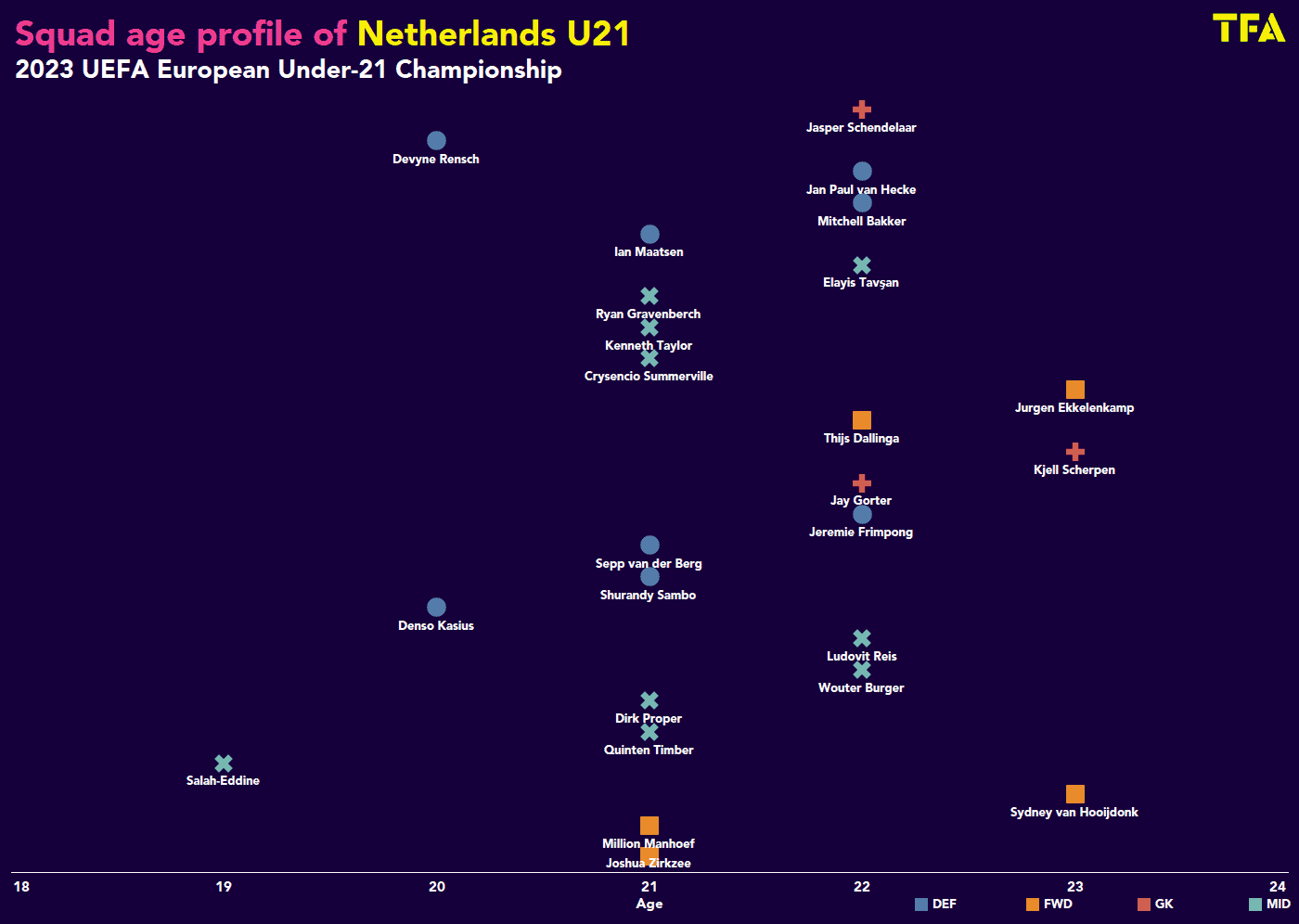
Attacking Phase
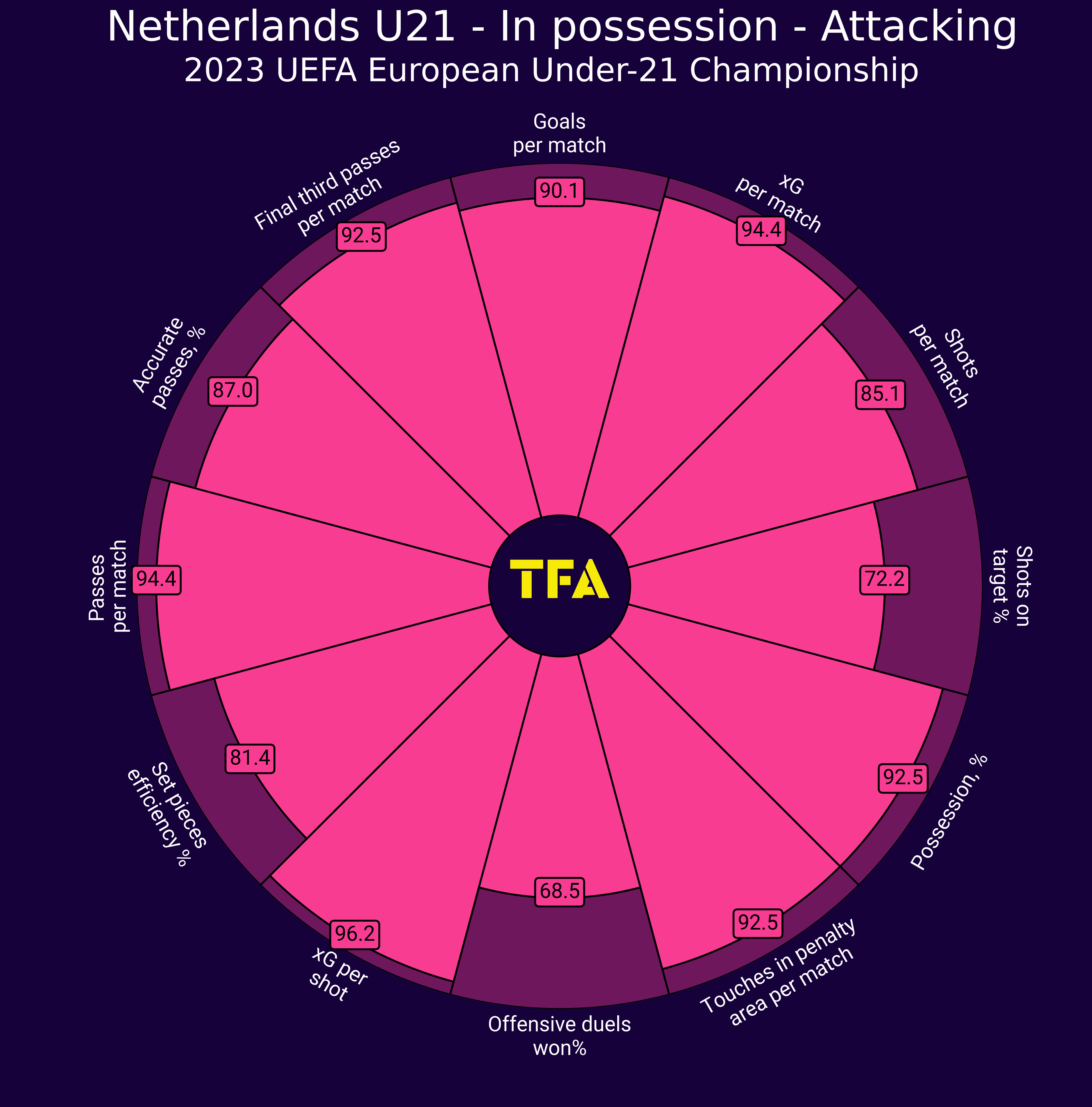
The Netherlands play the same way across all age levels and have done so for over half a century. With that being said, the U21s’ style of play should come as no surprise to anyone.
Van de Looi wants his players to have plenty of possession, build their attacks starting from the goalkeeper and be in constant control of the game through the use of the ball. Over the past 12 months, the U21s have registered an average ball possession of 65% in each game.
Then, out of possession, the Dutch side must be hungry to regain the ball as quickly as possible, counterpressing as well as pressing in a high block, depending on the situation.
Through our analysis of the Netherlands’ U21s team, we found that their build-up play shares a lot of similarities with Roberto De Zerbi’s Brighton and Hove Albion. The Italian coach has become somewhat revolutionary with how he approaches build-up play, provoking the opposition to commit bodies forward and baiting them to press before playing risky passes through the central areas.
To do so, De Zerbi always plays with a double-pivot that can bounce off one another. This is normally through the deployment of the 4-2-3-1 formation.
In the first phase, Van de Looi has taken a lot of inspiration from the Seagulls’ head coach, including the use of a double-pivot to great effect in the build-up phase while utilising a similar shape too.
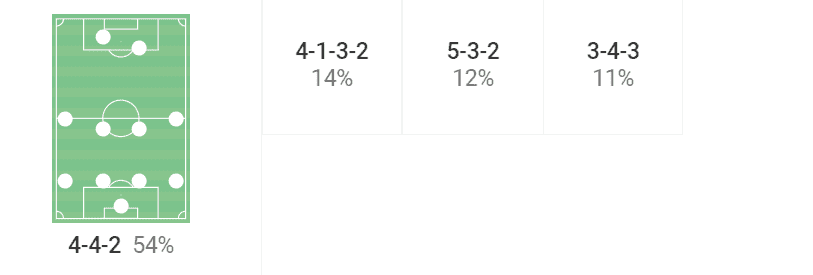
For the most part, the Netherlands set up in a 4-4-2 base formation, although this primarily applies to their structure out of possession. However, what it does tell us is that Jong Oranje use a double-pivot and these two central midfield players form the fulcrum of the side’s possession system.
In the first third of the pitch, the fullbacks stay low while the centre-backs split the goalkeeper. The central defenders are as deep as pitch dimensions allow, sometimes just an inch from the byline to bait the opposition to press as high as possible.
Furthermore, the double-pivot sit outside the penalty area, behind the opponent’s first line of pressure. They are not on the same horizontal line, though, and stagger their positioning to make it more difficult for the opposite team to defend against.

The objective is to bait the opposition, stalling on the ball until a marker jumps forward. The double-pivot’s role is to constantly move into space to open a passing lane from the backline to ensure that the ball is not intercepted in such a dangerous area. If this goes wrong, it can spell disaster as the opponent will have a transition inside the Netherlands’ own penalty area.
This all needs to be done within a matter of seconds. The double-pivot must open up a passing lane and have the correct body orientation to receive under pressure before quickly turning out and progressing the ball behind the opposition’s midfield line.
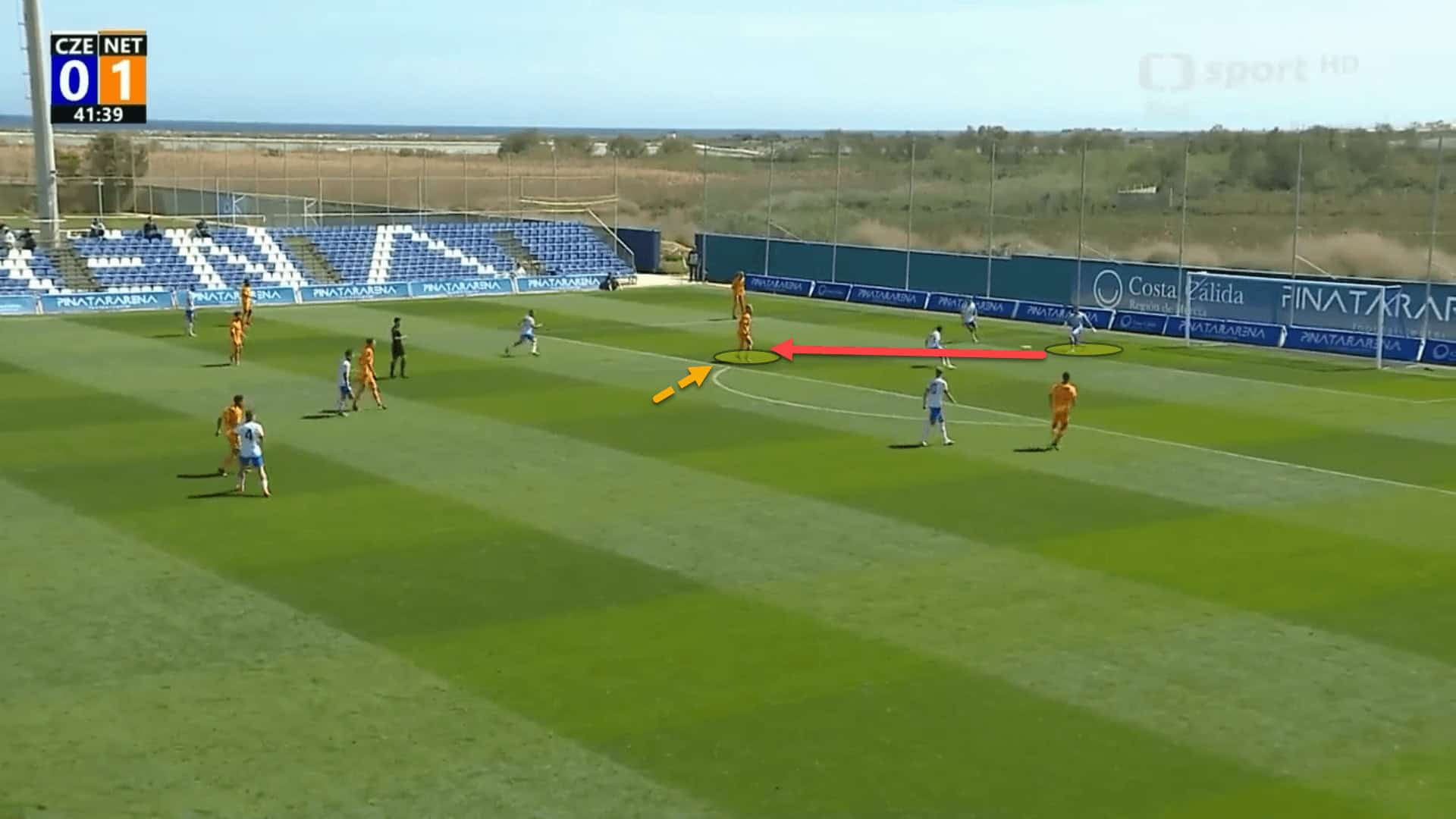
Here, the goalkeeper is being closed down by the Czech Republic forward. Quite a lot of goalkeepers in this situation would pump it long to the centre-forward, but not in Van de Looi’s Dutch team. Instead, he has seen that one of the pivot players has positioned himself perfectly behind the opposition’s first line of pressure and so slips the ball into his feet.
From there, the midfielder can use the third-man pass of the right centre-back or else try and take the ball on the half-turn, backing himself to beat the pressure from behind.
The strategy is inherently risky but Van de Looi has drilled his side impeccably, putting the right profile of players in each position to achieve the goal of bypassing the opponent’s high press.
It is also quite common to see some positional rotations in this area of the pitch, namely having one of the pivots dropping out wide as a temporary fullback while another player moves into the central spaces.

Here, Burger has moved out to become an auxiliary left-back during the build-up phase. To ensure that there is no loss of balance, the left-back has come into the pivot zone. As a result of Burger’s movement, the opposition’s block was stretched, allowing a passing lane to open from the centre-back to left-back Salah-Eddine Oulad M’Hand.
Again, it all comes down to team selection and the manager making sure that the right profile of players are selected to play this unorthodox style. Salah-Eddine is a central midfielder by trade and so having him play as an inverted left-back is an intelligent and sensible move by the head coach, particularly since he wants to have a lot of positional rotations within the team.
Further up the pitch, when the Netherlands have established possession against the defending side’s block, things become a little trickier and the structure changes, but the principles are the same.
They use a 3-2 substructure at the base of each positional attack. Again, the left-back inverts while the right-back tucks inside and becomes a third central defender, like how Manchester City play this season.
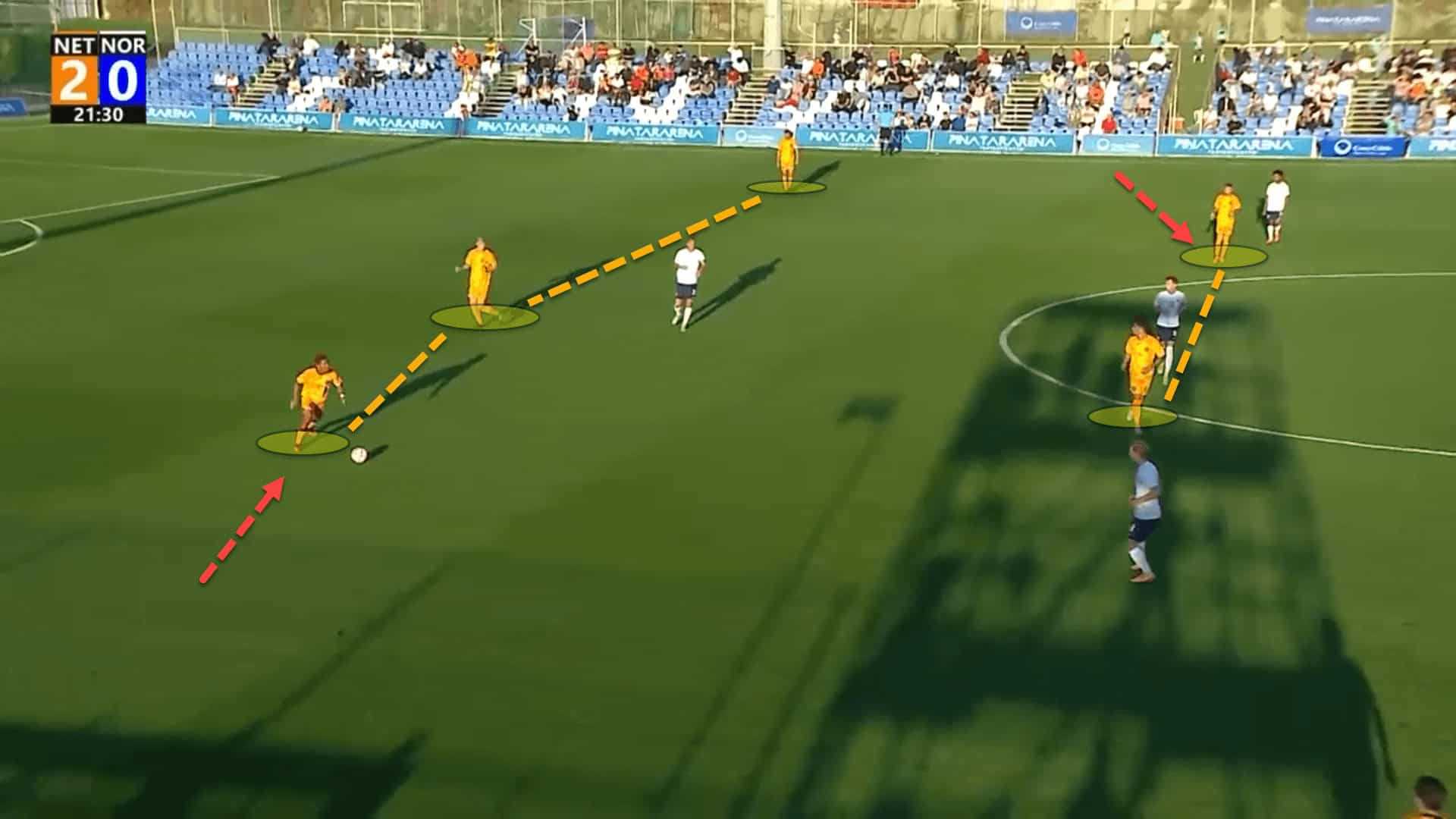
It is also quite common for one of the two forwards to drop very deep and be handed a free role to receive behind the opposition’s midfield.
This depends on the players that Van de Looi chooses. However, typically, one of the front two is more creative and is afforded license to drop deep, such as Jurgen Ekkelenkamp, while the other stretches the space behind the backline with runs and can be labelled as more of an out-and-out number ‘9’; Thijs Dallinga springs to mind.
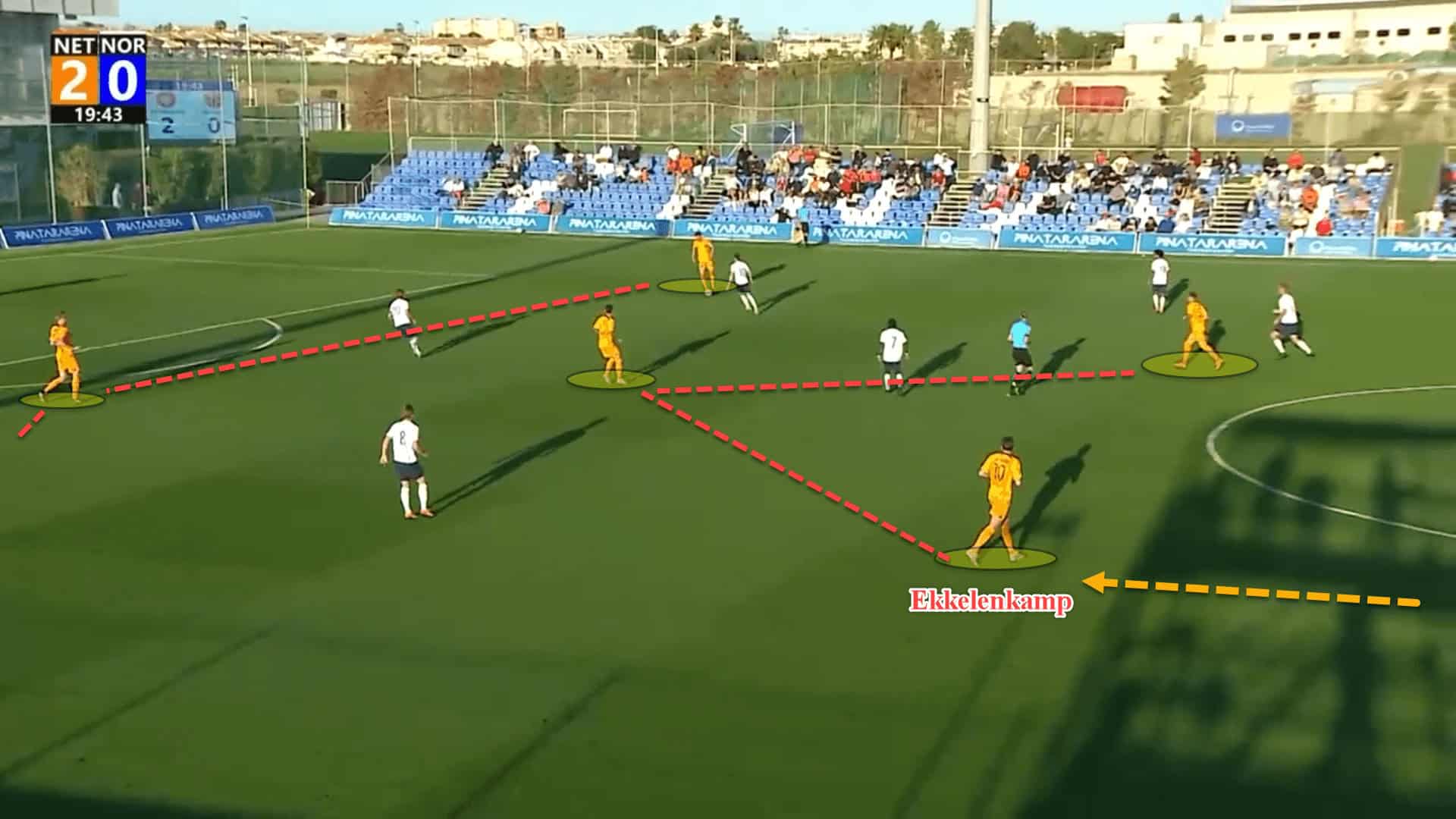
In this game against Norway, Royal Antwerp’s Ekkelenkamp constantly dropped into the right halfspace in deeper areas despite being used as a number ‘9’ on the teamsheet and out of possession. When the 22-year-old technician would drop into this area, the base substructure would change from a 3-2 to a 3-3.
The main objective for the Netherlands is to get in behind the opposition’s defensive line. This is ideally done by reaching the players between the lines who can then turn and play forward, slipping in runners who are through on goal.
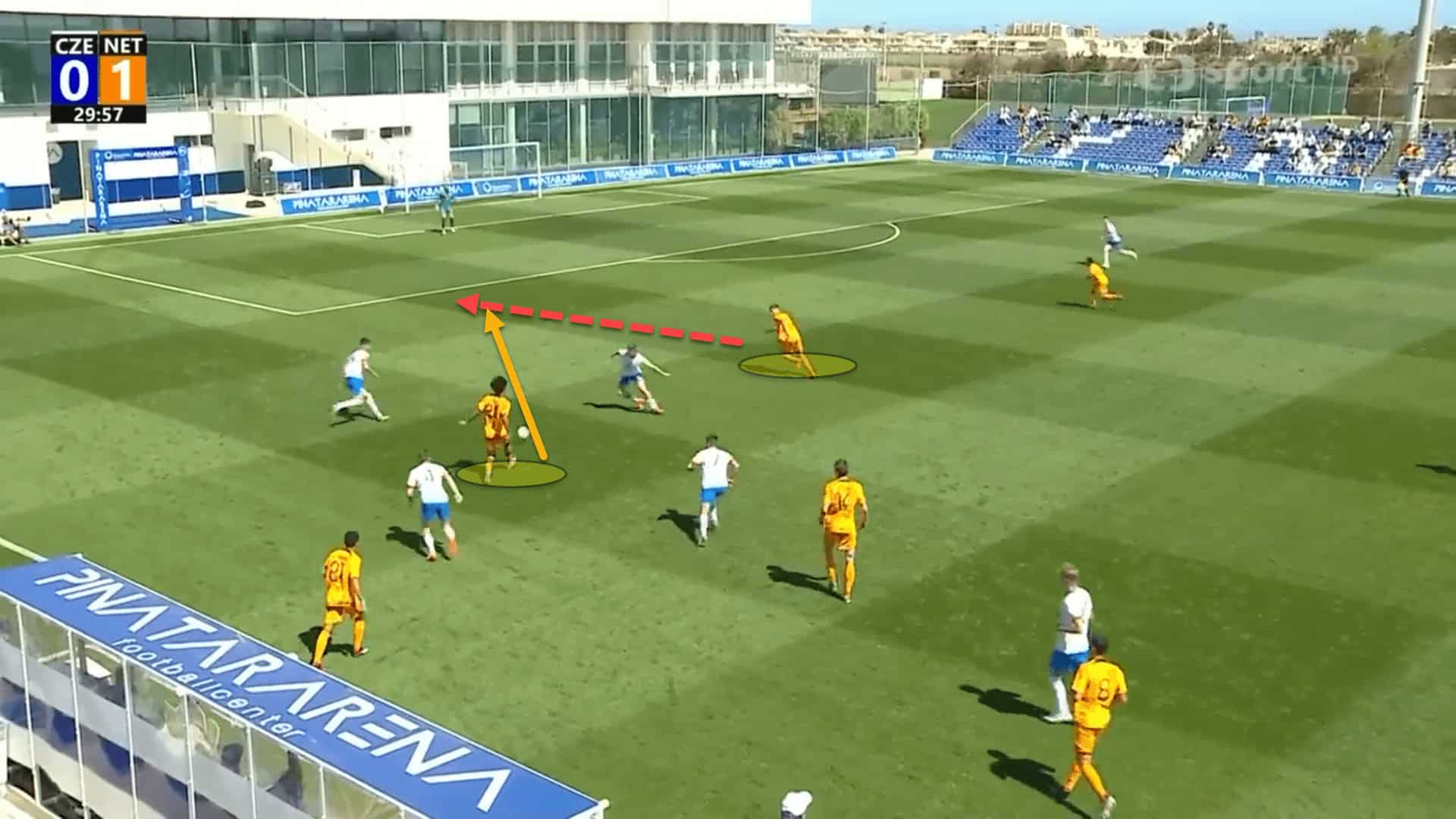
Van de Looi gives his players the freedom to use their own quality to dribble directly at goal. Having tricky wingers such as Crycensio Summerville in the team massively aids this as Summerville is exceptional in 1v1 situations and can beat any defender on his day.
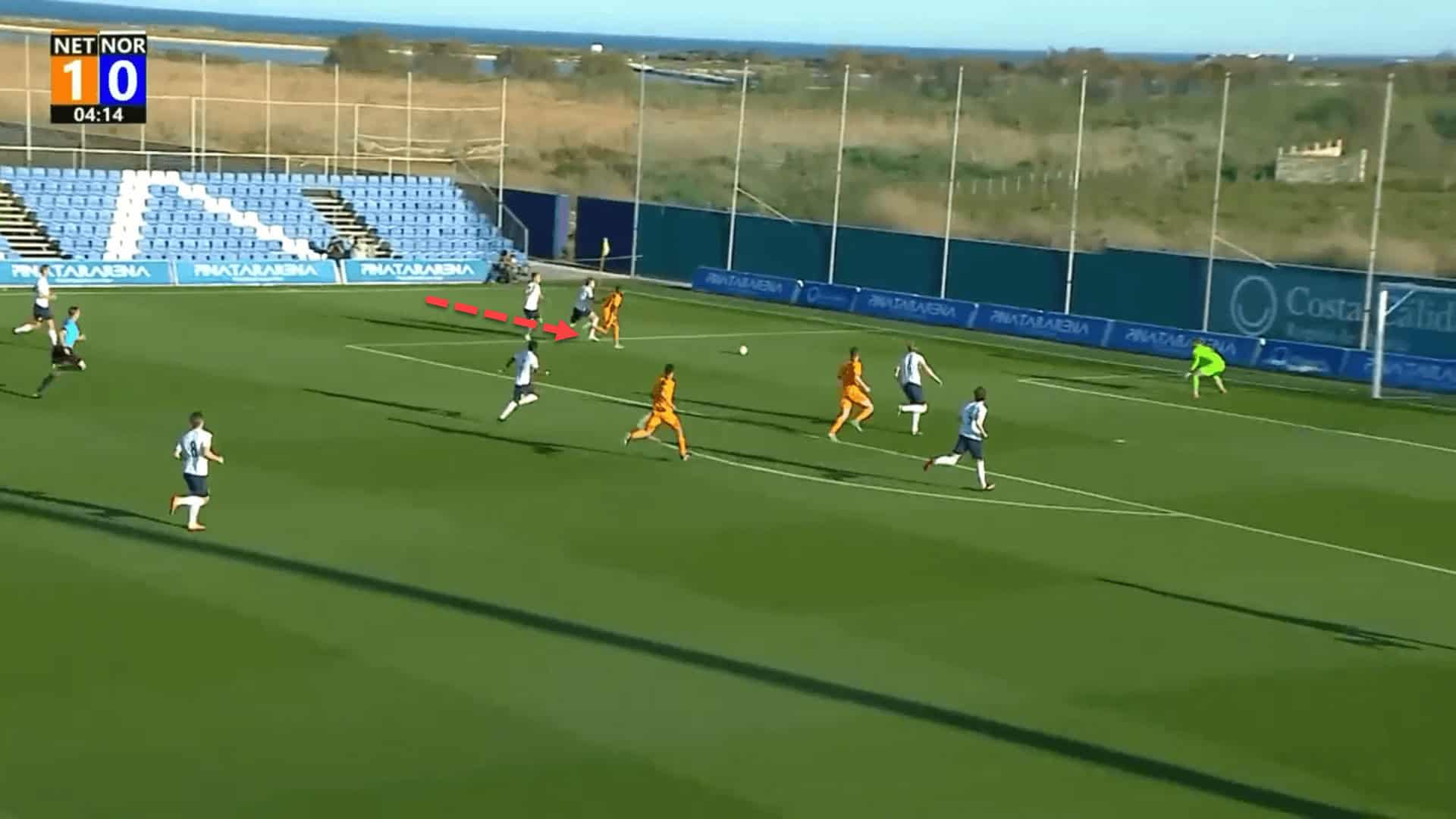
In this example from a recent friendly against Norway’s U21s, Summerville took on two players at once, pushing the ball in between both defenders before chipping the goalkeeper to bag the Netherlands’ second goal of the game.
The Jong Oranje have been deadly in front of goal too, creating a lot of chances while also scoring them. Over the past calendar year, Van de Looi’s team have averaged 2.23 xG per game, including friendlies, while scoring 2.29 which is an overperformance.
But how are the Netherlands performing defensively?
Defensive Phase
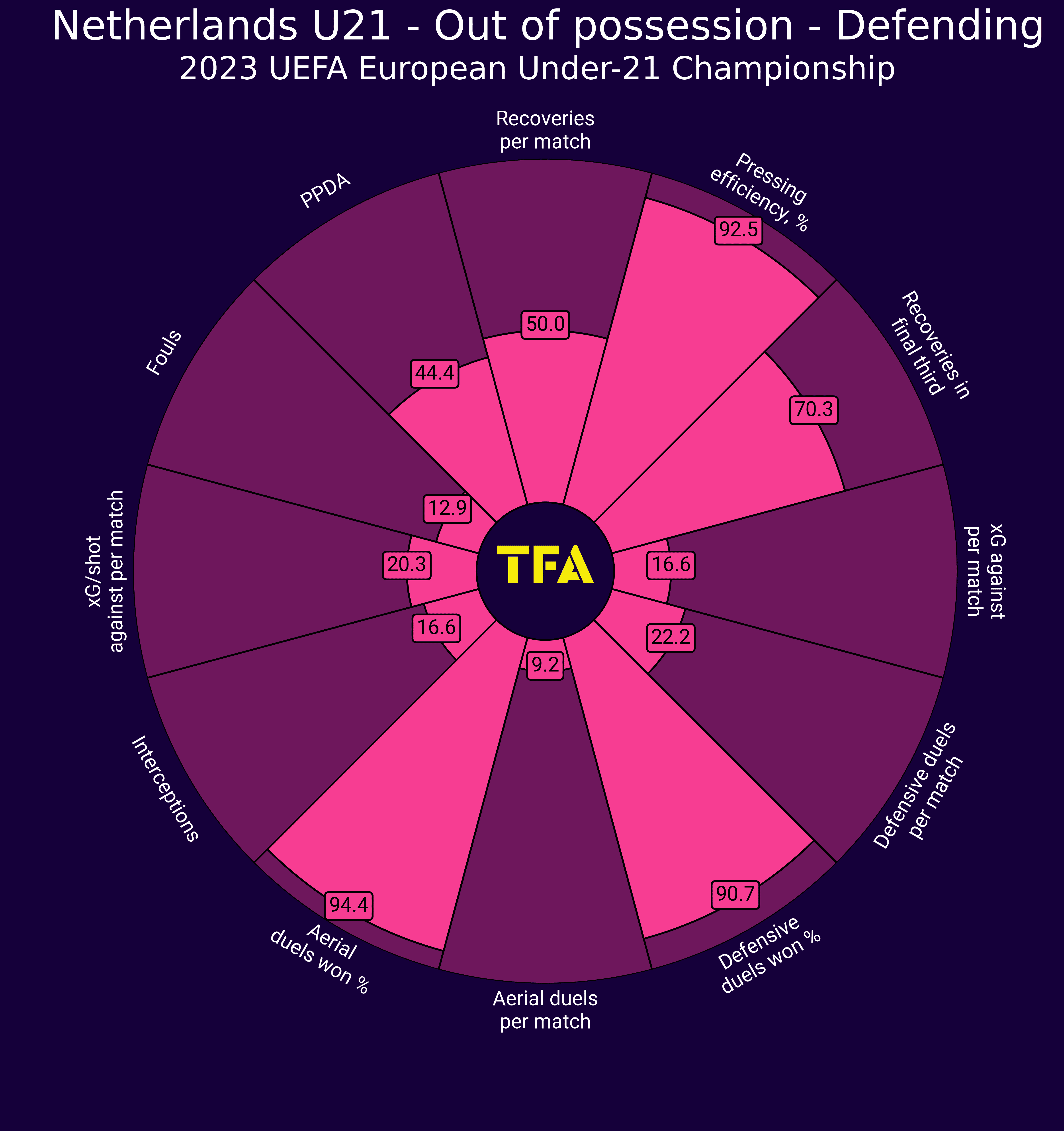
Looking at the previous pizza chart, the nation’s style in the defensive phase is quite telling.
There is nothing too unconventional about the Netherlands’ tactics in the defensive phase. Van de Looi wants his side to be effective out of possession, though, pressing high up the pitch and making life as uncomfortable as possible for the team on the ball.
Defending has never been an art necessarily associated with the Dutch national team, or any of its youth groups for that matter. However, over time, the Dutch FA knew that to keep in line with their philosophy of having the ball, a demand for high pressing was needed across the board. There is no point in wanting to control a game with the ball but sitting off in a low block for large periods of the match.
Hence, all teams that wear the famous orange shirt must press high and work hard to regain possession of the ball as close to the opposition’s goal as possible. But how each team goes about doing this is at the discretion of each head coach.
As aforementioned, the Netherlands’ U21s side play within the confines of a 4-4-2 formation which takes form the most out of possession. Nonetheless, when sitting in a low block, the shape resembles more of a 4-3-1-2.
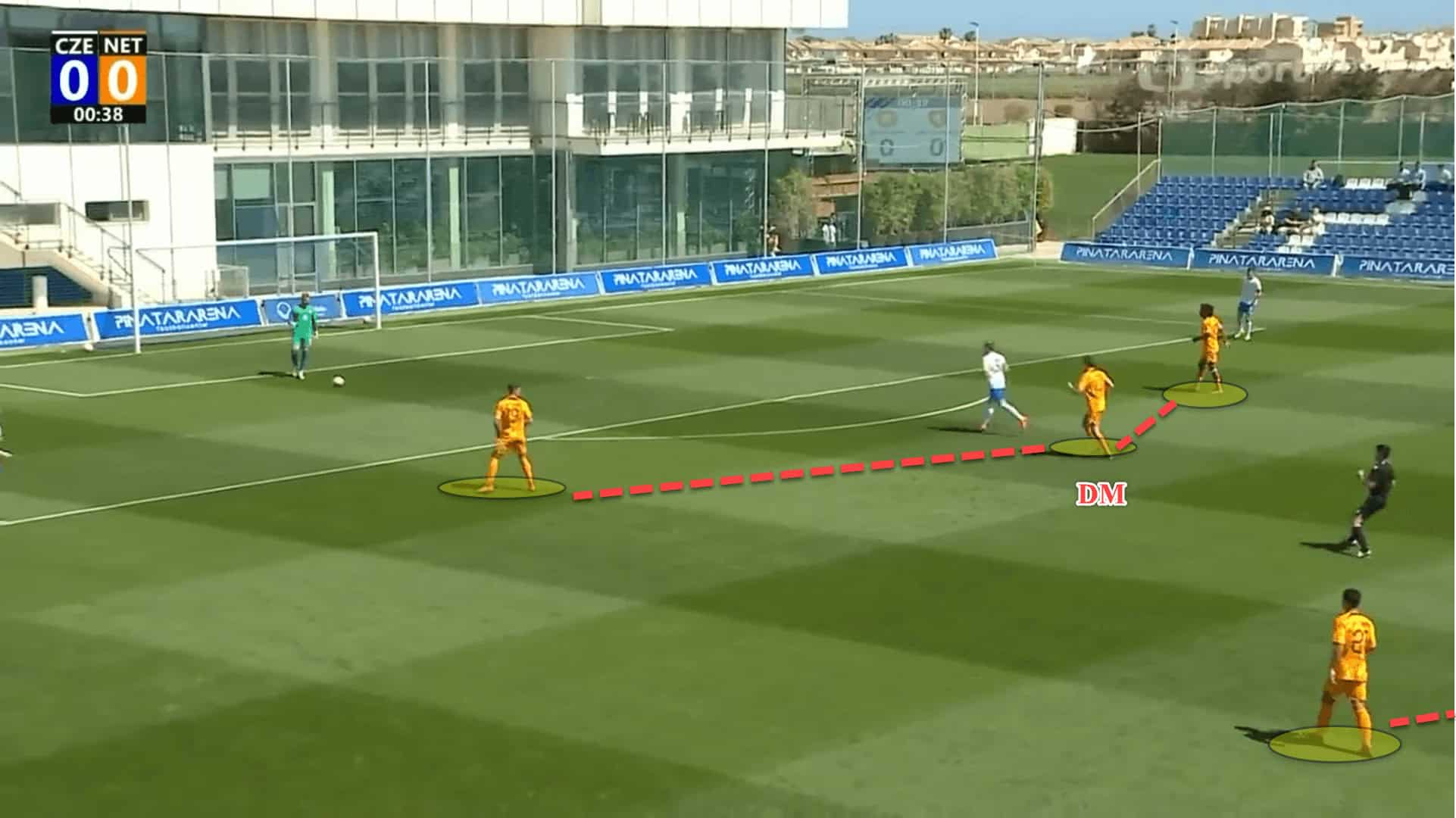
Here, Jong Oranje were pressing the Czech Republic in the final third. Burger had pushed up to mark the deepest Czech midfielder to deter the team in possession from progressing the ball through the ‘6’. Meanwhile, the other central midfielder in the Netherlands’ double-pivot sat back to protect the backline from long balls and second balls alongside the two wingers who tucked inside ever so slightly.
The centre-forwards lead the press in this temporary 4-3-1-2 and are instructed to press in-to-out, forcing the opposition to play down the flanks where the ball can be repossessed easier by using the touchline as an extra defender.
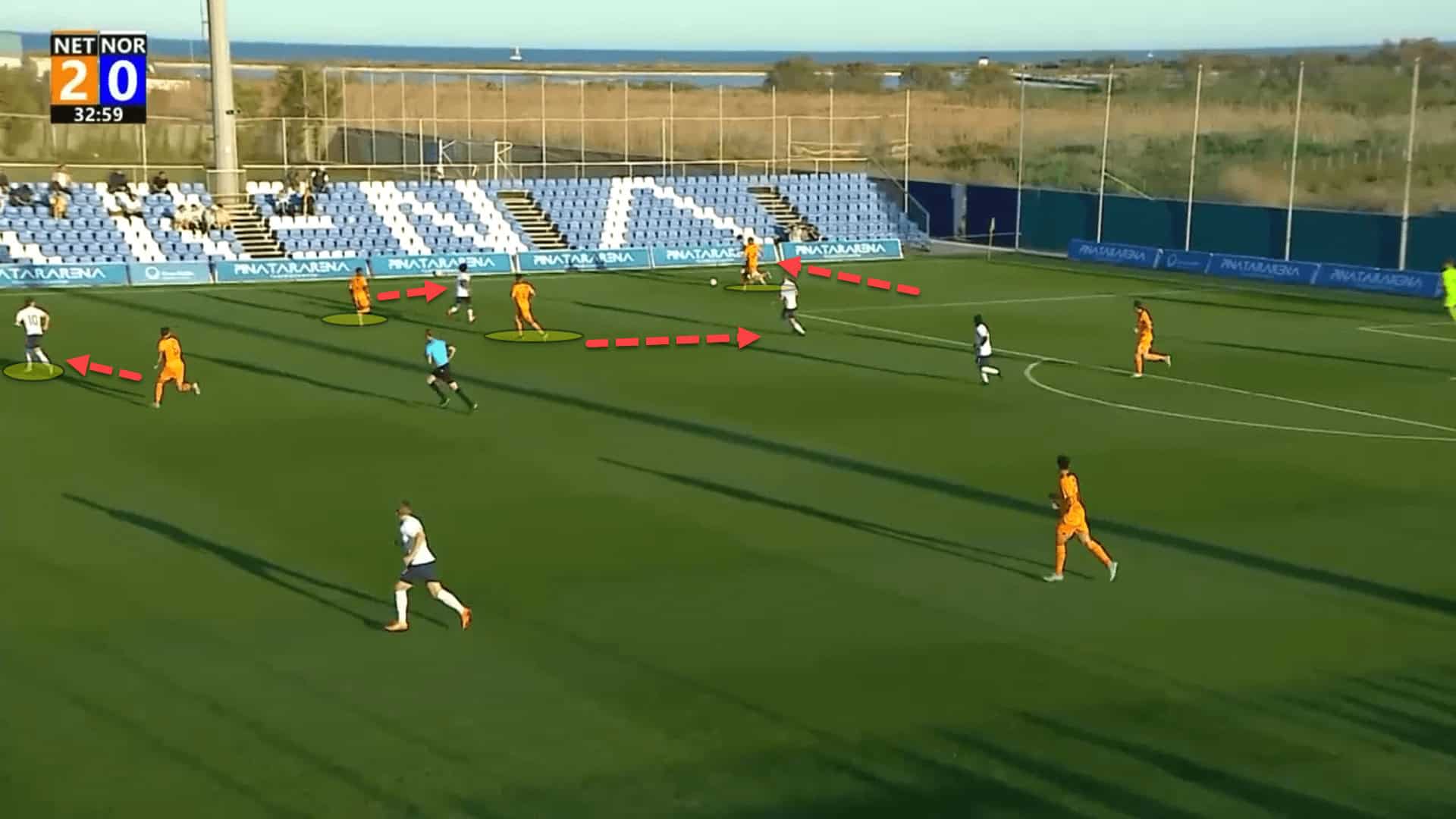
Once the ball is moved out to the wide areas, the Netherlands switch up their pressing approach, moving from a zonal press to a man-oriented press. The block shifts across to the ball side, the players lock on to the nearest player and they press aggressively to recoup the ball and potentially begin a transition.
Again, it’s not innovative but it’s certainly effective. The players are well-drilled on how to press the opposition as well as how to adapt to different situations if the attacking side rotate or interchange positions.
Lower down the pitch, the team drop into a very compact 4-4-2 shape. The Netherlands start out in a 4-4-2 mid-block and want to stay here as long as possible ideally, but are comfortable when dropping into an even deeper block.
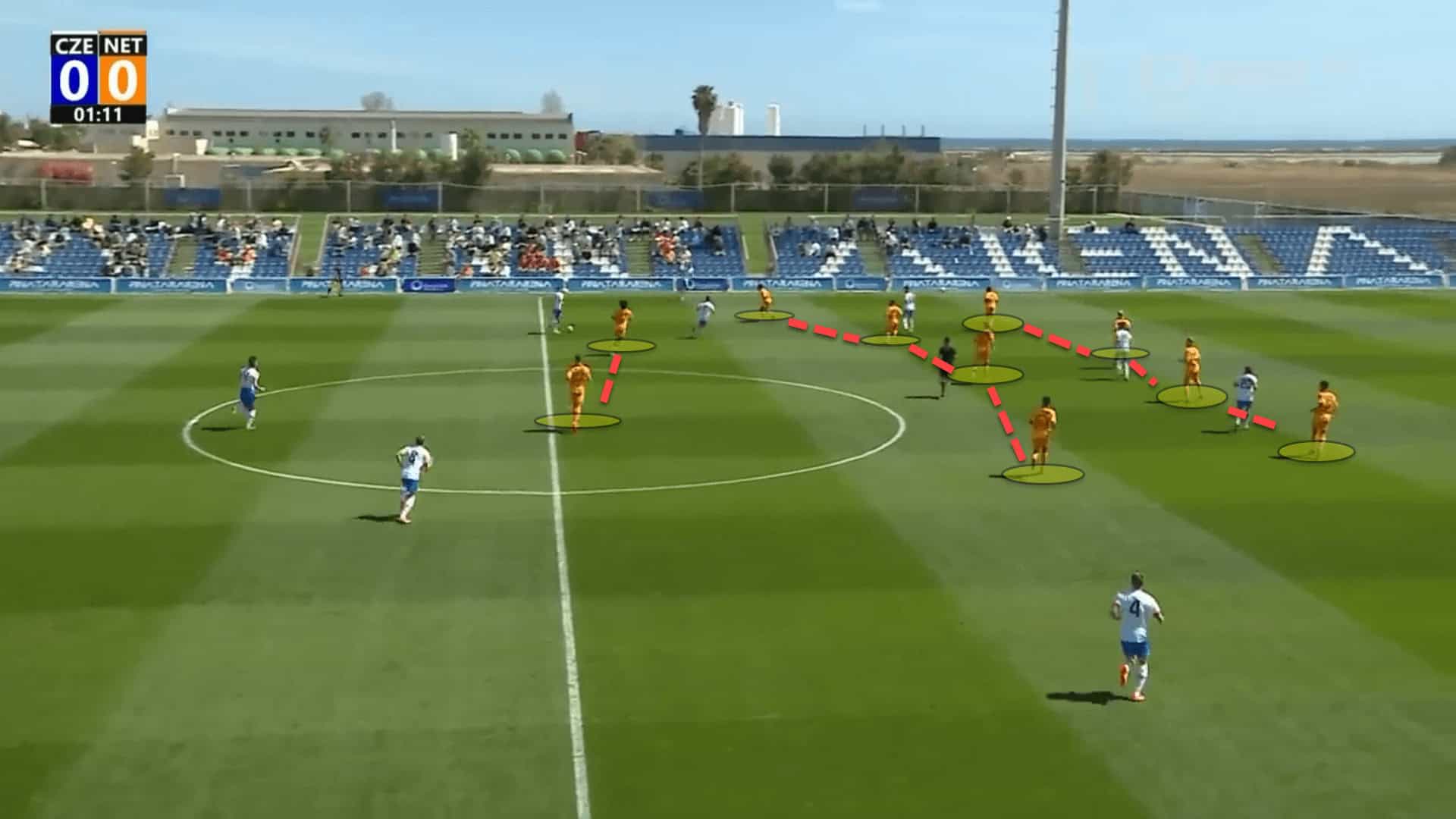
The aim is to keep the space between the lines to a minimum. Van de Looi wants the block to shift from side to side depending on where the ball is, all the while ensuring that the 4-4-2 doesn’t lose its compactness.
Sometimes, when watching the Dutch U21s side, the block is so compact, it almost looks a little nonsensical.
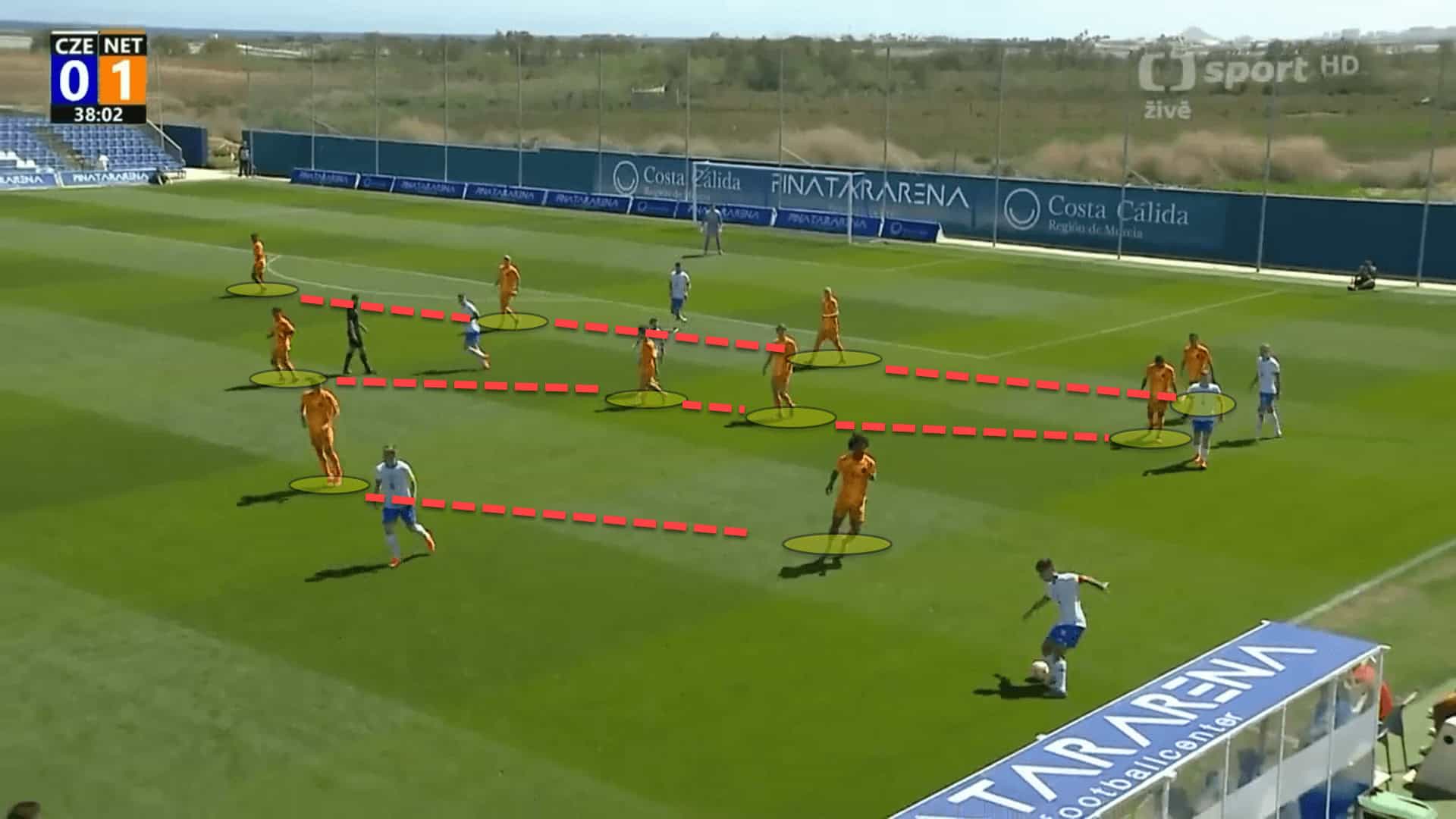
However, it’s certainly effective against teams that want to try and progress through the central areas, although such a condensed shape can make the Netherlands susceptible to switches of play.
Regardless, they haven’t had too many issues defensively, and the stats show that. Over the past calendar year, the Netherlands U21s have conceded an average of 0.93 xG per game and an average of 0.23 goals per game. This is quite a large outperformance which can be attributed to many factors such as poor finishing from the opposition, excellent goalkeeping as well as top-notch defending.
However, with a record of 0.23 goals against per game and 2.29 goals per game, this Dutch side are certainly a threat to anyone hoping to lift the crown this summer.
Transitions
Transitions are an important part of the Netherlands’ playing style, primarily defensive transitions.
As mentioned in the previous section, Van de Looi wants to control games by controlling the share of possession and so wants to win it back as quickly as possible. When attacks break down, the manager demands that his players counterpress swiftly and with numbers to recover the ball in a threatening area.
The Netherlands like to use high counterpressing recoveries to their advantage. Having the centre-backs primed and ready to step up and jump opponents from behind in very high areas is vital to this.
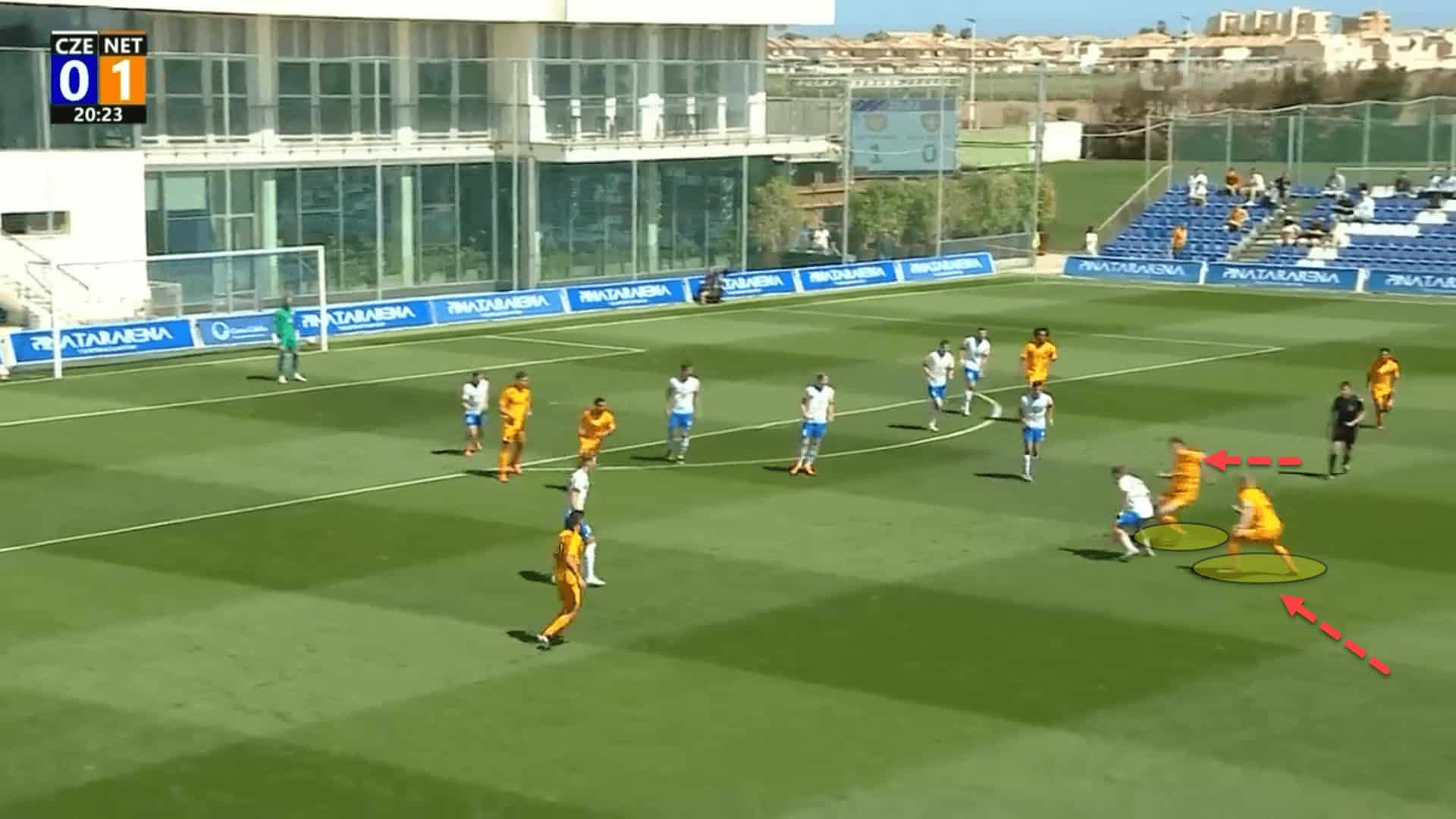
Here, Jong Oranje have just lost the ball near the final third but the nearest centre-back had already anticipated the problem and stepped forward to nick the ball back for his side. This strategy is incredibly risky of course, especially since the central defender can be caught out of position, but Van de Looi believes the risk is worth taking which is admirable.
Furthermore, it must also be said that building up from the back with a 3-2 substructure at the base of the positional attack is a security move by Van de Looi.
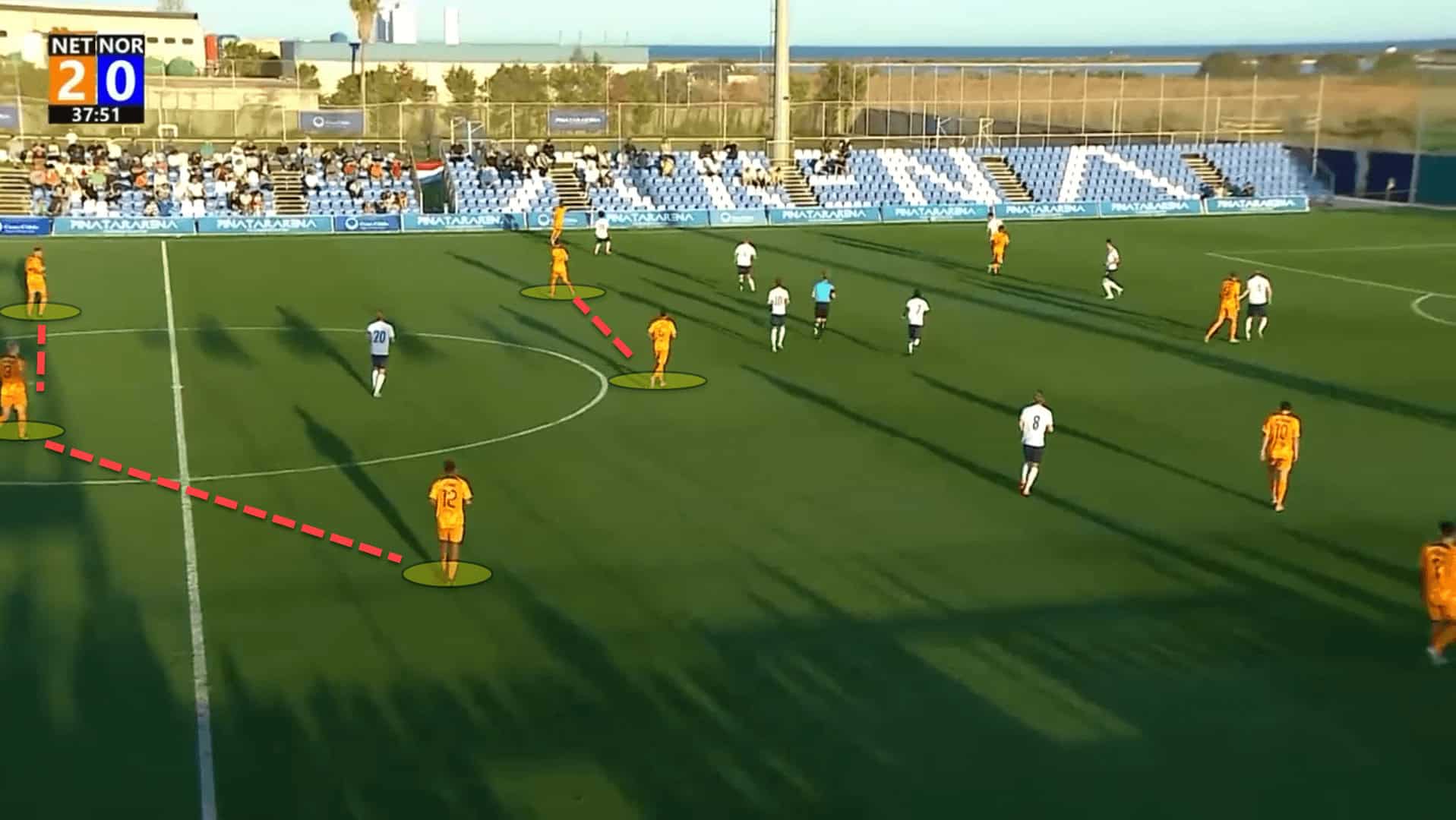
As analysed in a previous section, one fullback inverts next to the deepest midfielder while the other fullback tucks inside to create a back-three. In this respect, the Netherlands have the entire back-four and one central midfielder back to defend transitions in case the ball is turned over.
This is the same reason why both Pep Guardiola and Thomas Tuchel prefer to use a 3-2 at the base as it offers that little bit extra security to stifle opposition counterattacks.
Attackers
There is some wonderful variety in the Netherlands’ attacking arsenal heading into this tournament.
Van de Looi has some fine talents available at his disposal, including several players who have comfortably integrated themselves into first-team football in their respective leagues such as Thijs Dallinga. The Toulouse centre-forward has scored 12 goals in Ligue 1 this season for the newly-promoted side, just a few behind the great Lionel Messi.
Meanwhile, Sydney van Hooijdonk is the third top goalscorer in the Eredivisie, as of writing, and has been in unbelievable form for Heerenveen this season. Even Joshua Zirkzee is a solid option up top for Van de Looi. While the former Bayern Munich youngster hasn’t really been firing for Bologna in Serie A, he still has the talent to be effective at U21 level.
Furthermore, with wingers like Leeds’ Crysencio Summerville and NEC’s Elayis Tavşan, the Netherlands will be a constant threat to opposition fullbacks in this competition as the wide players will look to feed the strikers and even chip in with some goals themselves.
Midfielders
The midfield department is arguably the area where the Netherlands are the strongest. One could even argue that this Dutch midfield is the best in the competition, although the likes of England and France will have a thing or two to say about that.
With players such as Ajax’s established star Kenneth Taylor and Bayern Munich’s highly-rated gem, formerly of Ajax, Ryan Gravenberch, it is going to be incredibly difficult for any nation to go toe-to-toe with the Netherlands in a midfield battle.
There is even some excellent cover for these technicians such as Wouter Burger and Ludovit Reis who were partnered as the double pivots for the Netherlands’ recent international friendlies in March.
With that amount of depth and quality, there is plenty of competition within the ranks and it allows Van de Looi to rotate for certain games when required to give players a massively beneficial rest.
Defenders
The backline is another area where the Netherlands have great strength in depth and have players who are featuring for some top sides across the continent.
Even the fullback positions are stacked, with the likes of Bayer Leverkusen’s Jeremie Frimpong as well as Ajax’s Devyne Rensch on the right and Chelsea loanee Ian Maatsen on the left. Meanwhile, Leverkusen’s Mitchel Bakker can play on both the left and in the centre and Salah-Eddine Oulad M’Hand can slot in at left-back.
At the heart of the defence, though, Van de Looi has primarily preferred to use the duo of Bakker and Jan Paul van Hecke, who has been making waves at Brighton this season, although Liverpool youngster Sepp van der Berg is in with a shout of starting too.
Unfortunately, the Dutch squad could be without the presence of Newcastle United’s Sven Botman who may not be brought as part of the team which would have added immense quality to the centre-back partnership.
Key Player
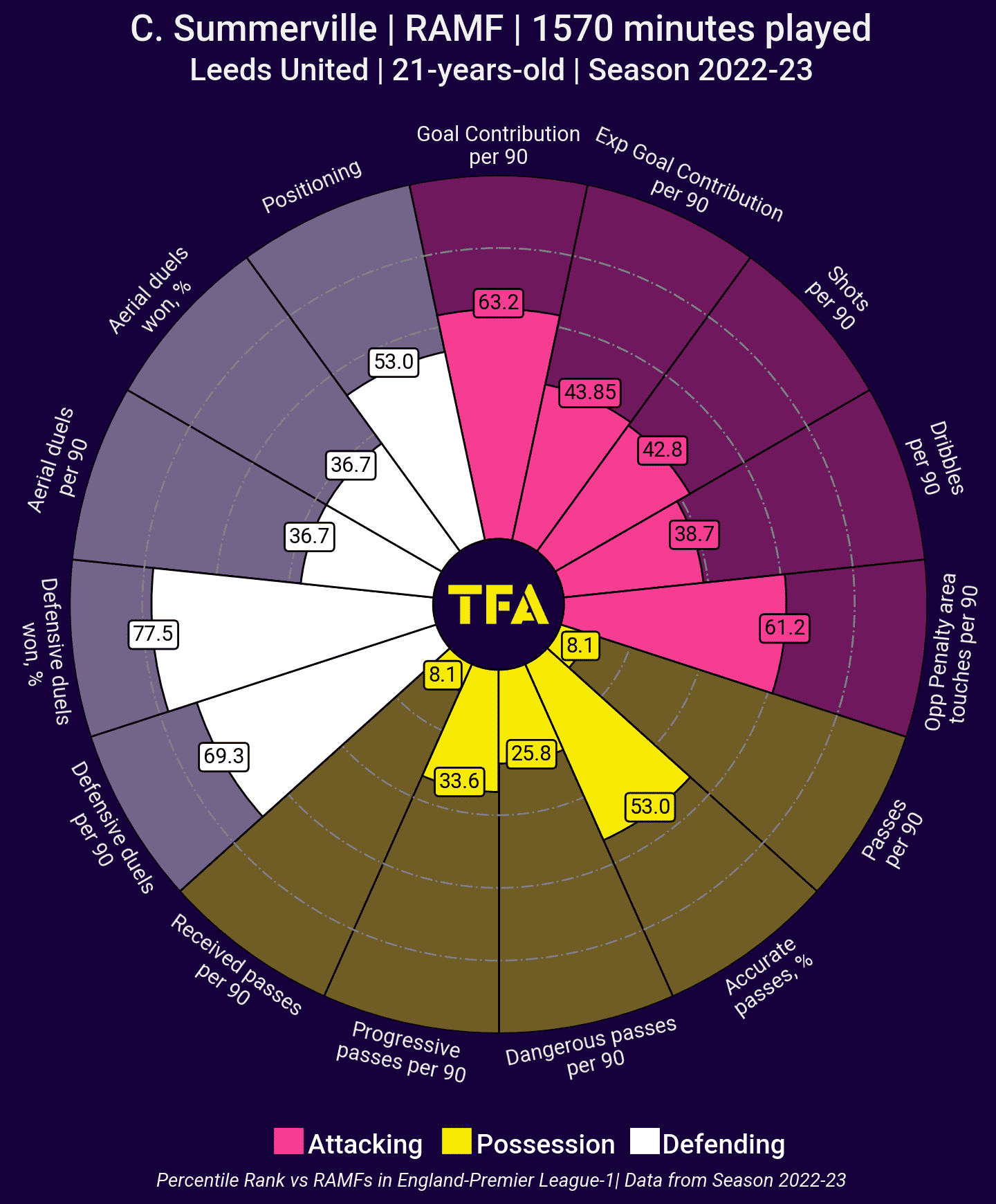
It was an incredibly tough call to pick who will be the Netherlands’ best player this summer in EURO U21 considering the sheer wealth of talent to choose from — we can only imagine what is going through Van de Looi’s head!
However, we’ve decided on Leeds United’s Crysencio Summerville who has had a solid season at Elland Road. But his performances in Yorkshire are not the reason we chose Summerville as the Netherlands’ main man for this competition.
The pick was based on the Dutch side’s two friendlies against the Czech Republic and Norway. Summerville didn’t start in the match against the former but did for the latter game. The difference between the performance of the Dutch team was night and day.
Summerville was so threatening down the left and can also play off the right as well as through the middle if Van de Looi is really looking for something different.
The youngster’s speed, agility, directness, power, precision and prowess make him such a menace on the football pitch and the country will be hoping he can showcase his qualities in Romania and Georgia to potentially lead his team to victory for the first time in 16 years.
Tournament prediction
The Netherlands are undoubtedly one of the strongest teams heading into this tournament. With some real gems in the ranks and a manager hoping to prove his worth before leaving after the competition, this Dutch team could finally put the ghosts of previous U21s tournaments behind them.
However, even if Jong Oranje don’t go deep in the Euros, their style of play will still be a joy to watch, as we have analysed in-depth in this scout report, so keep your eye out for their upcoming matches. You’re in for a footballing treat!

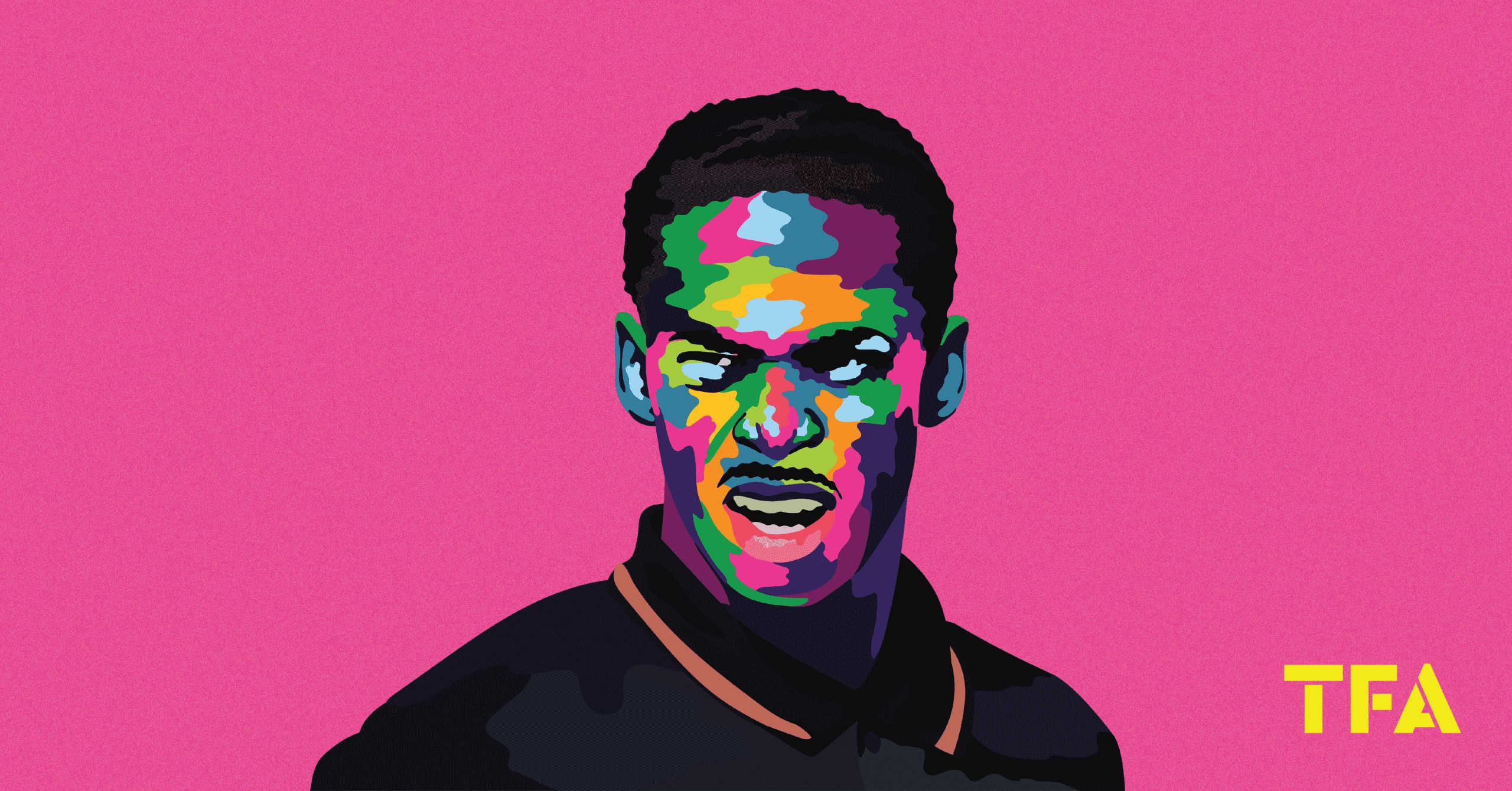




Comments